Breast augmentation is a solution that helps women achieve a fuller, firmer, and more attractive bust. Not only does it simply improve breast size, but it also helps women feel more confident about themselves. So, what does breast augmentation mean? What are the different kinds of breast augmentation? Refer to this article to understand more deeply about this cosmetic surgery method.
What is breast augmentation?
Breast augmentation, also known as breast augmentation surgery, is a cosmetic surgical method aimed at increasing size, improving shape, and enhancing the fullness of the bust. This procedure is commonly performed by placing breast implants under the breast tissue or chest muscles.
In addition, there is another breast augmentation procedure called fat transfer breast augmentation, which involves taking fat from other parts of the body and injecting it into the breasts. It can be said that breast augmentation is a solution that helps women achieve a more balanced figure and feel more confident about their bodies.
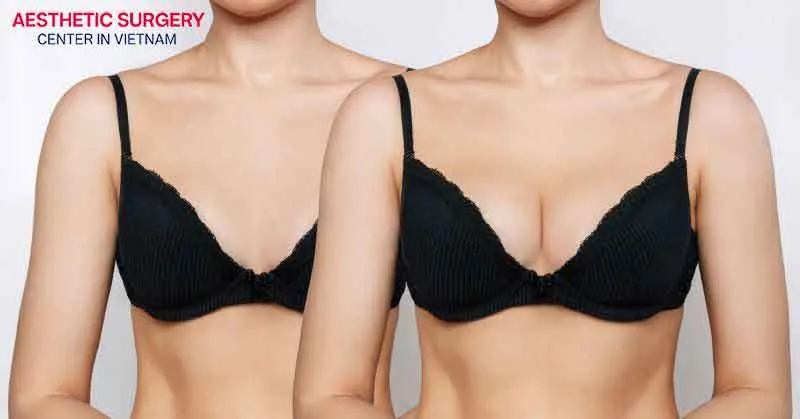
What are the different kinds of breast augmentation?
Based on the content about what breast augmentation surgery is, we can determine different kinds of breast augmentation. Typically, there are 2 main types: fat transfer breast augmentation and implant-based breast augmentation. Each type has different characteristics, various options, and distinct advantages and disadvantages. Therefore, to ensure safety and avoid risks during breast augmentation surgery, it is important to thoroughly understand each type.
Implant-based breast augmentation
Implant-based breast augmentation, also known as breast implant surgery, is a cosmetic procedure that enhances the bust using implants, which are inserted into the breast pocket through a small incision. Currently, there are several types of breast implants as follows:
Silicone breast implants: As the name suggests, these implants are made of silicone gel with high cohesiveness. This type of gel maintains its shape even when the implant is cut in half, helping prevent leakage if the shell is damaged.
There are 2 types of silicone implants: traditional and form-stable, also known as gummy bear implants. Silicone implants offer a soft, natural feel similar to real breast tissue, maintain shape well, and are less likely to wrinkle. In particular, this type of implant has been FDA-approved for women aged 22 and above. However, if a leak or rupture occurs, the silicone gel is not absorbed by the body, and surgery is required to remove or replace the implant.
Saline breast implants: These implants have an outer silicone shell filled with sterile saltwater solution. They are inserted empty and filled to the desired size by the doctor afterward. There are two shapes of saline implants: round and teardrop-shaped.
Advantages of saline implants include customizable sizing and safety in case of a leak or rupture, as the saline is absorbed and naturally eliminated by the body. They are also cheaper than silicone implants and FDA-approved for women aged 18 and above. However, they may not feel as natural as silicone, and in some cases, they may wrinkle or ripple under the skin, especially in those with thin breast tissue.
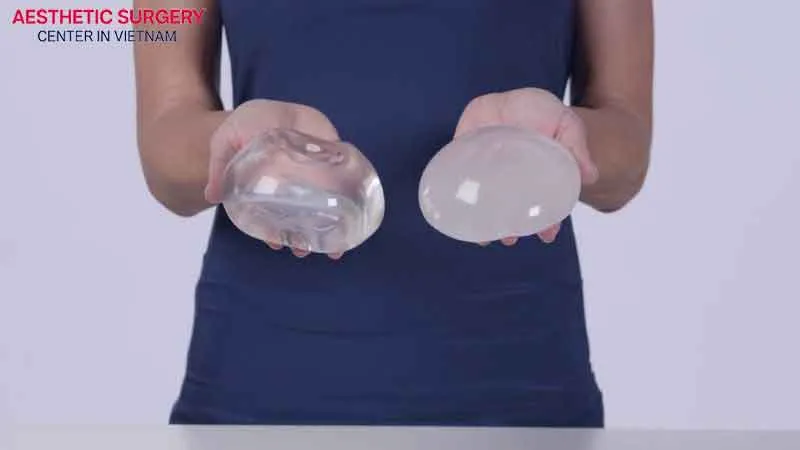
Teardrop-shaped implants: These implants are shaped like a teardrop, with a slimmer top and fuller bottom, mimicking the natural contour of the breast. They are often used for individuals with small breasts seeking natural-looking results, those lacking natural breast tissue, or in breast reconstruction. Teardrop-shaped implants usually have a textured surface to prevent rotation.
Round implants: These implants have a symmetrical round shape that provides fullness in both the upper and lower breast. They are suitable for those seeking a fuller, rounder look, especially in the upper breast, or for individuals with flat or mildly sagging breasts looking to improve projection.
Smooth implants: These implants have a smooth outer shell, offering the softest and most natural feel to the touch, and they move easily with the body. However, they have a higher risk of capsular contracture more easily than textured implants and may rotate.
Textured implants: These have a rough surface created by tiny granules, which helps the implant adhere better to breast tissue, reducing rotation and the risk of capsular contracture. However, they are not as soft as smooth implants. In very rare cases, they may be linked to a type of lymphoma (BIA-ALCL), although modern textured implants have been improved to minimize this risk.
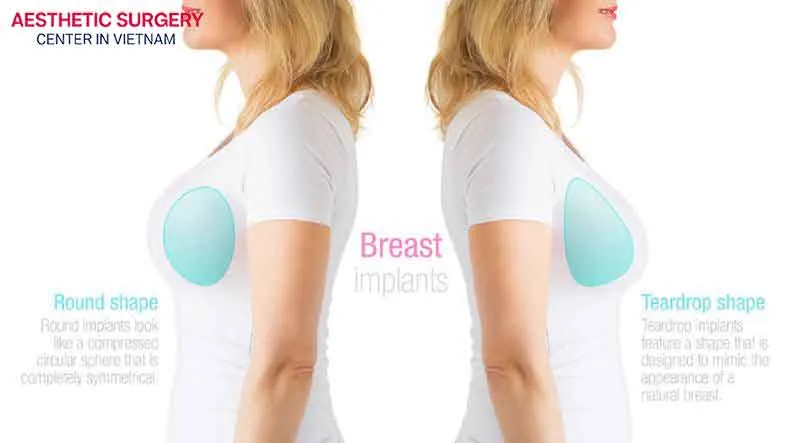
Fat transfer breast augmentation
Fat transfer breast augmentation is a method that involves harvesting fat from other areas of the body, such as the abdomen, thighs, hips, back, etc., through liposuction. The fat is then processed and directly injected into the breast area. This type of breast augmentation gives a natural, soft appearance, does not use artificial materials, ensures safety, and also helps reduce fat in unwanted areas.
However, this method provides only a limited increase in breast size, typically only 1 to 2 cup sizes. Some of the injected fat may be absorbed by the body over time, and the body must have an adequate amount of excess fat to be harvested. Therefore, this method is suitable for those who want a relatively modest increase in breast size.
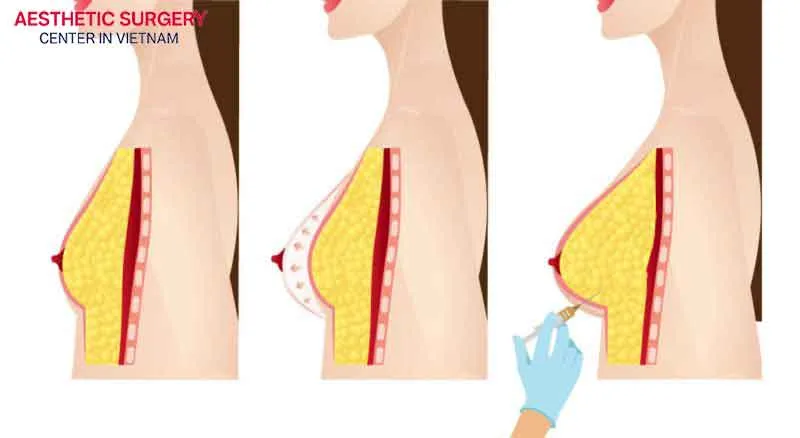
Based on the above classifications, you can choose the breast augmentation method you desire. However, keep in mind that some of the methods mentioned are only FDA-approved for certain age groups. To ensure safety when selecting a breast augmentation method, besides researching them, you should consult with a doctor to make the most appropriate choice.
Why do people get breast augmentations?
Breast augmentation brings many benefits, but the main reason women choose it is to improve the shape and size of their breasts. Details include:
- Increase breast size: Those with small, modest breasts or who feel their breasts are not proportionate to their body may choose breast augmentation to achieve a more harmonious figure.
- Improve symmetry: Breast augmentation helps correct asymmetry in size or shape between the two breasts.
- Restore shape: Breast augmentation is a solution that helps women regain fullness and firmness in the breasts after bodily changes due to pregnancy, breastfeeding, or weight loss.
- Boost confidence: A full, well-proportioned bust can help women feel more confident in choosing clothing, in communication, and in everyday life. More importantly, breast augmentation helps women improve their appearance, enhances femininity and attractiveness, thereby increasing satisfaction, self-love, and appreciation for their bodies.
- Reconstruction after mastectomy: For breast cancer patients, breast reconstruction surgery helps them restore a complete body image, reduce feelings of inferiority, and recover both physically and mentally.
- Immediate and lasting results: After breast augmentation, women will immediately see changes in size and shape. In particular, modern breast implants are highly durable, come with long-term warranties, and can maintain aesthetic results for many years, even decades.

It is clear that breast augmentation can offer many significant benefits, from improving breast size and creating a balanced, attractive figure to boosting self-confidence and enhancing quality of life. However, it is important to research thoroughly, prepare carefully, choose a reputable cosmetic surgery facility, and consult with a specialist plastic surgeon to ensure safety, minimize risks, and achieve the desired results.
How do I prepare for breast augmentation surgery?
Thorough preparation before breast augmentation surgery is a crucial factor that greatly determines the success of the procedure, ensures safety, optimizes aesthetic results, and promotes quick recovery. Therefore, before undergoing breast augmentation surgery, you need to carefully prepare the following:
- Choose a reputable breast augmentation facility with certified, experienced plastic surgeons and a large, trustworthy hospital licensed by the Ministry of Health to perform major surgery.
- Schedule a direct consultation with the doctor to clearly understand the surgical method, type of implant, potential risks, complications, procedure steps, and costs. At the same time, share with the doctor your desired breast size and shape so they can recommend the most suitable implant size for your body.
- Stop smoking, including electronic cigarettes, and avoid alcohol for at least 2–4 weeks before surgery. These substances negatively affect blood circulation, anesthesia, and wound healing.
- Stop using medications that may cause blood thinning, such as Aspirin, Ibuprofen, Cocaine, vitamin E, fish oil, herbal supplements, etc., for at least 2 weeks before surgery.
- Carefully consider the following: Breast augmentation does not stop sagging; implants are not permanent, and breast sensation may change.
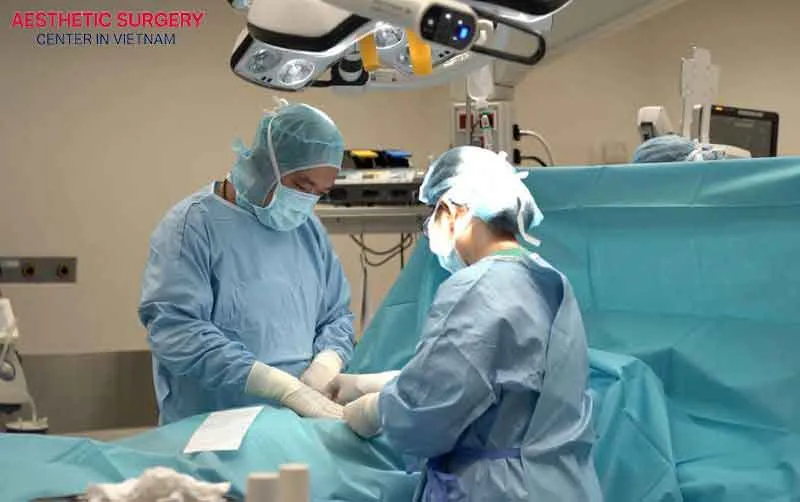
What happens in a breast augmentation surgery?
To clearly understand what happens in a breast augmentation surgery, you can refer to the entire process before, during, and after the procedure:
Before the procedure
- Before undergoing breast augmentation, the doctor will instruct you to stop taking certain medications such as aspirin, anti-inflammatory drugs, and supplements that may affect blood clotting; you will also need to fast according to the doctor’s instructions to ensure safety during anesthesia.
- The doctor will examine the current condition of your breasts and listen to your expectations regarding the desired breast size and shape.
- A general health check will be conducted, including blood tests, an electrocardiogram, and a chest X-ray to ensure you are healthy enough for the surgery. At the same time, the doctor will ask about your medical history, such as heart disease, blood pressure, diabetes, blood clotting disorders, and any history of allergies to anesthesia, local anesthesia, or antibiotics. If you have any of these conditions, you must inform your doctor for a detailed consultation.
- The doctor will advise you on the different kinds of breast augmentation, including the advantages and disadvantages of each. If you choose to have implants, you will be informed about the types of implants, sizes, shapes, and implant placement options.
- The doctor will take measurements, draw and outline the breast shape, determine balanced proportions, and mark the implant placement position to ensure the aesthetic outcome is beautiful, natural, and proportional to your body.
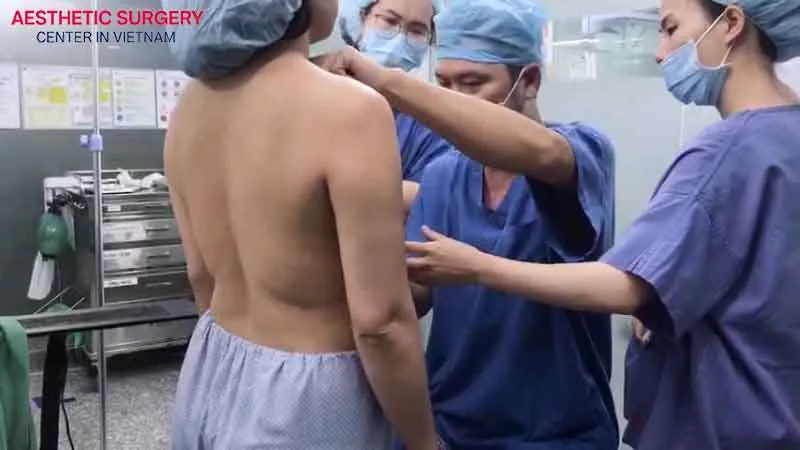
During the procedure
- Step 1: Anesthesia: The doctor will administer general anesthesia or local anesthesia, depending on their decision and the patient’s health condition, ensuring that the patient feels no pain during the surgery.
- Step 2: Making the incision: A small incision will be made at the predetermined location, such as the inframammary fold, around the areola, through the armpit, or through the navel (as previously discussed with the patient).
- Step 3: Creating the pocket: The doctor will dissect the tissue to create a sufficiently empty and wide pocket to place the implant. The pocket may be located behind the mammary gland tissue, behind the chest muscle, or behind the pectoral fascia, but in front of the chest muscle.
- Step 4: Placing the implant: The doctor will insert the previously selected implant into the created pocket. Then, a thorough check will be performed to ensure the implant is placed correctly, symmetrically, and in harmony with the body’s figure.
- Step 5: Suturing the wound: The doctor will close the incision using cosmetic sutures and place a drainage tube if necessary.
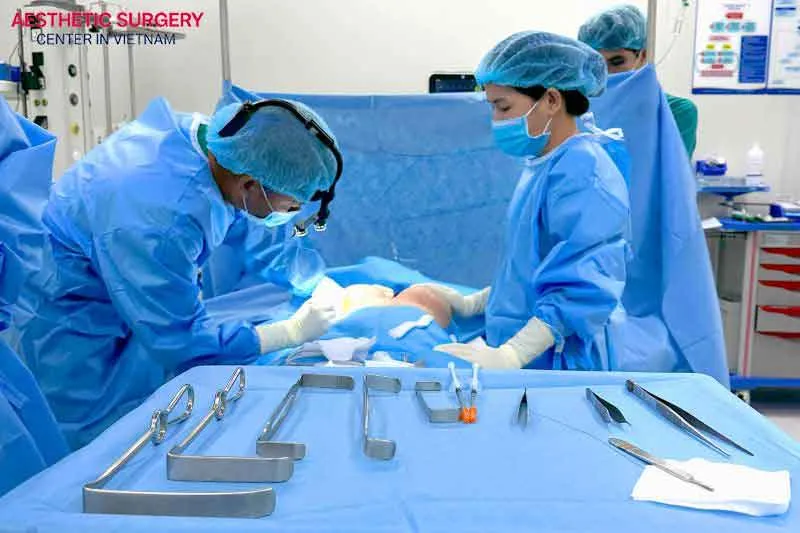
After the procedure
- The patient will be moved to the recovery room for monitoring of vital signs and post-operative symptoms. Depending on their health condition, the doctor will allow the patient to return home the same day or stay in the hospital for 1–2 days for observation.
- The doctor or nurse will provide detailed instructions on how to take care of the wound at home, such as keeping the incision clean
- The doctor will prescribe pain relievers and antibiotics to manage pain and prevent infection. You need to take the medication as directed.
- Remember to change the dressing according to the doctor’s schedule. Stitches will be removed after 7–10 days (if non-dissolvable sutures are used).
- Wear a breast support garment as instructed by the doctor to help shape the breast and reduce swelling.
- Attend follow-up appointments as scheduled by the doctor to monitor the recovery process and detect any complications early (if any).
Breast augmentation before and after
To help you better visualize breast augmentation before and after, we will list a series of close-up images showing the results of clients who have undergone the procedure:
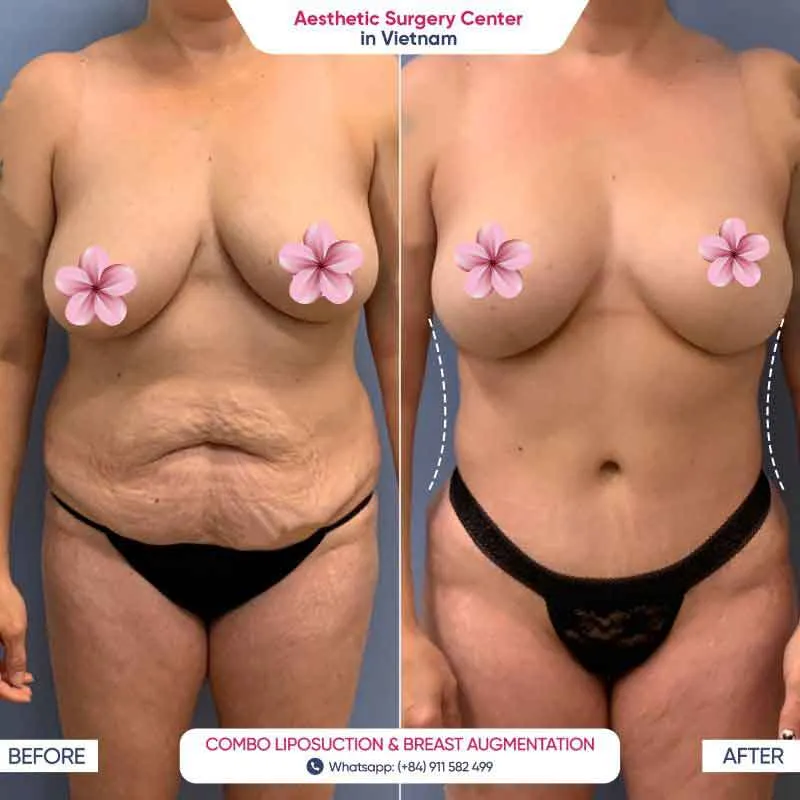
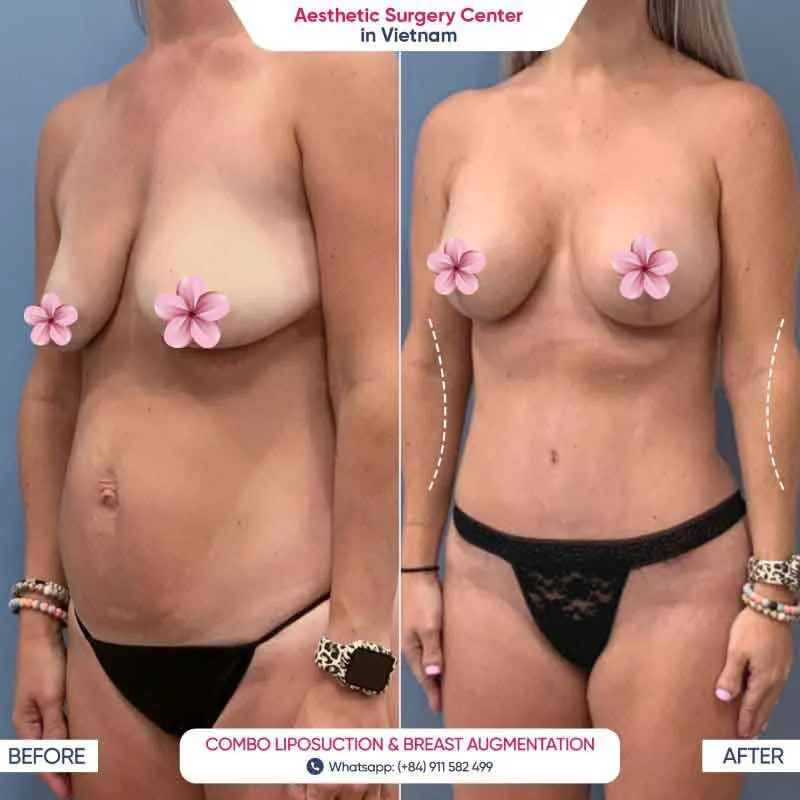
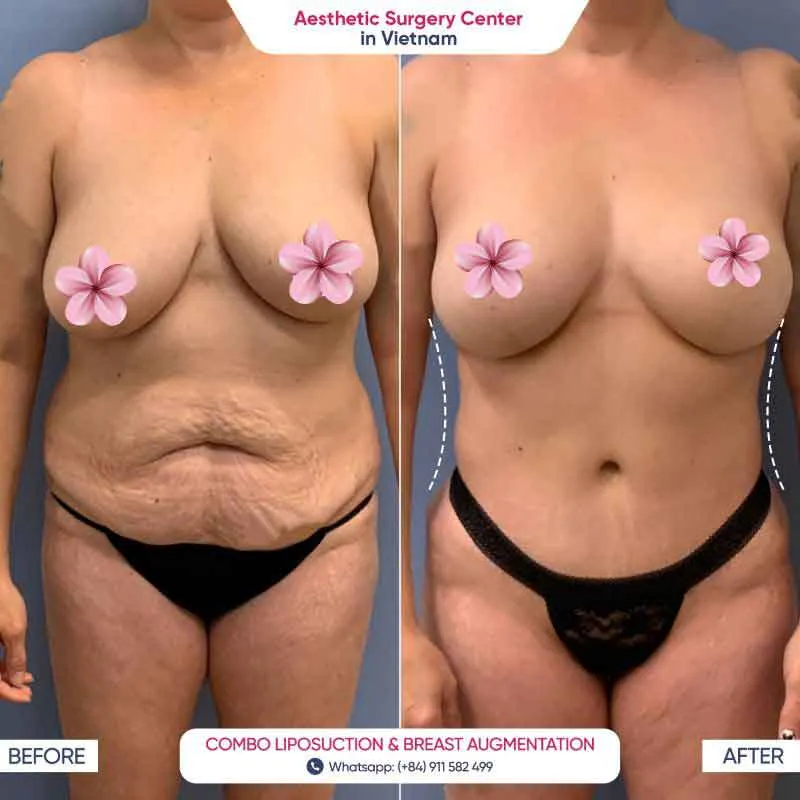
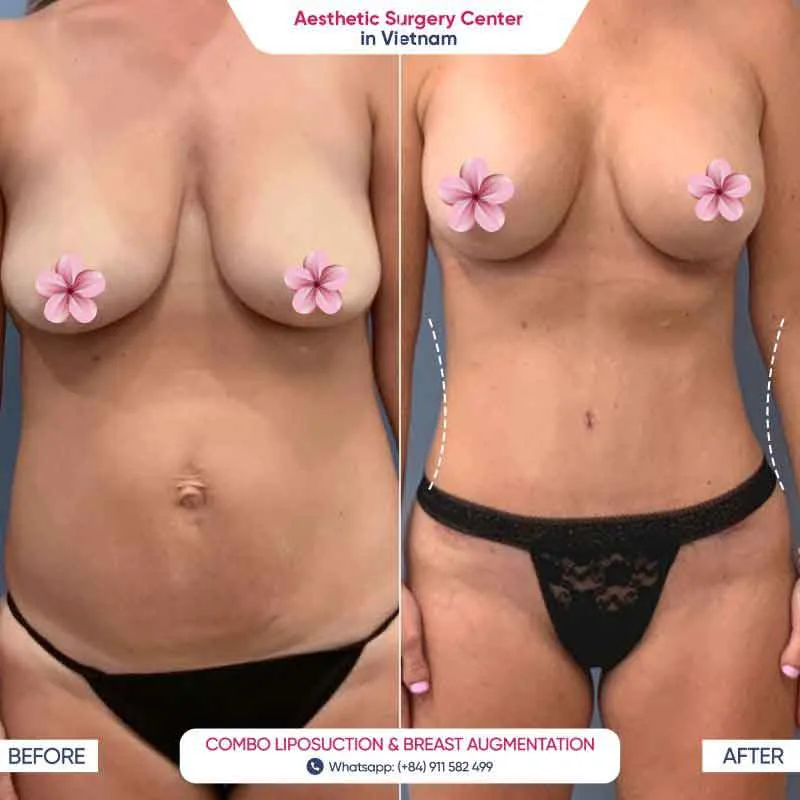
Post-breast augmentation care
After undergoing breast augmentation, you should pay attention to the following guidelines to promote faster healing, ensure your breasts settle into a natural shape, and prevent potential complications:
- In the first few days after surgery, you must rest completely and avoid any strenuous activities, heavy lifting, or movements such as raising your arms above shoulder height or reaching behind your back.
- For the first 1–2 days, if swelling occurs, you may gently apply a cold compress around the breast area to reduce swelling and bruising. After that, switch to warm compresses to improve blood circulation.
- It’s best to sleep on your back to avoid putting pressure on the chest, helping the incision heal more effectively.
- Wear a compression bra 24/7 for the first 1–3 months, depending on the implant type and surgical procedure used. This helps secure the implants in place, reduces swelling, and supports proper shaping.
- Avoid getting the incision wet during the first few days. Always keep the wound dry and clean. When cleaning your body, use a damp towel to wipe instead of taking a full shower.
- Use saline solution or antiseptic prescribed by your doctor to gently cleanse the area, then dry it with sterile gauze.
- Prioritize soft, easy-to-digest foods such as soup, porridge, or steamed/boiled dishes in the early recovery period.
- Eat plenty of leafy greens, fresh fruits, and protein-rich foods like lean meat, fish, eggs, milk, oranges, grapefruits, tangerines, guavas, bell peppers, and broccoli to boost immunity and support wound healing.
- Drink 2–2.5 liters of water per day to detoxify the body and accelerate the recovery process.
- Avoid foods that may cause keloid scars, pus formation, inflammation, or allergic reactions, which could hinder healing, such as water spinach, chicken, sticky rice, eggs, seafood, spicy foods, alcohol, smoking, and stimulants, for at least one month post-surgery.
- Don’t forget to take pain relievers, antibiotics, and anti-inflammatory medications exactly as prescribed by your doctor.
- Refrain from intense physical exercise, especially workouts involving the upper body, for at least 4–6 weeks or until cleared by your doctor.

Aesthetics Surgery Center – A trusted and safe destination for breast augmentation in Vietnam
Aesthetics Surgery Center is a renowned international aesthetic system in Vietnam, licensed by the Ministry of Health, ensuring adherence to strict standards of safety and medical quality. With dozens of branches across major and minor cities in Vietnam, each facility is fully equipped with modern technology, luxurious infrastructure, and a wide range of services, from skincare and high-tech beauty treatments to advanced plastic surgeries, including breast augmentation.
When it comes to breast augmentation, Aesthetics Surgery Center is considered one of the most reputable and trusted hospitals in Vietnam, chosen by many local and international clients. Here’s why:
- Aesthetics Surgery Center gathers a team of board-certified plastic surgeons with over 10 years of experience, many of whom have trained extensively overseas. These experts personally perform breast augmentation procedures, ensuring high precision, safety, and minimizing the risk of complications.
- The hospital invests heavily in advanced medical technologies and surgical equipment imported from leading countries in aesthetics, such as South Korea, the UK, France, etc.
- Aesthetics Surgery Center offers a wide range of breast implants with various materials such as silicone and saline, in different shapes like round or teardrop-shaped, and surface textures including smooth, textured, and nano-textured, allowing clients to choose the most suitable option based on their body type and personal preferences.
- The surgical procedure is carried out in a sterile operating room that meets medical standards, minimizing the risk of infection and ensuring client safety.
- Advanced breast augmentation procedures, such as endoscopic breast augmentation, are applied to make the procedure more comfortable, more precise, and less invasive.
- After surgery, clients can rest in fully equipped private recovery rooms, supporting optimal healing.
- Seoul Center also regularly offers attractive promotions and special deals, allowing clients to enjoy premium services at the best prices.
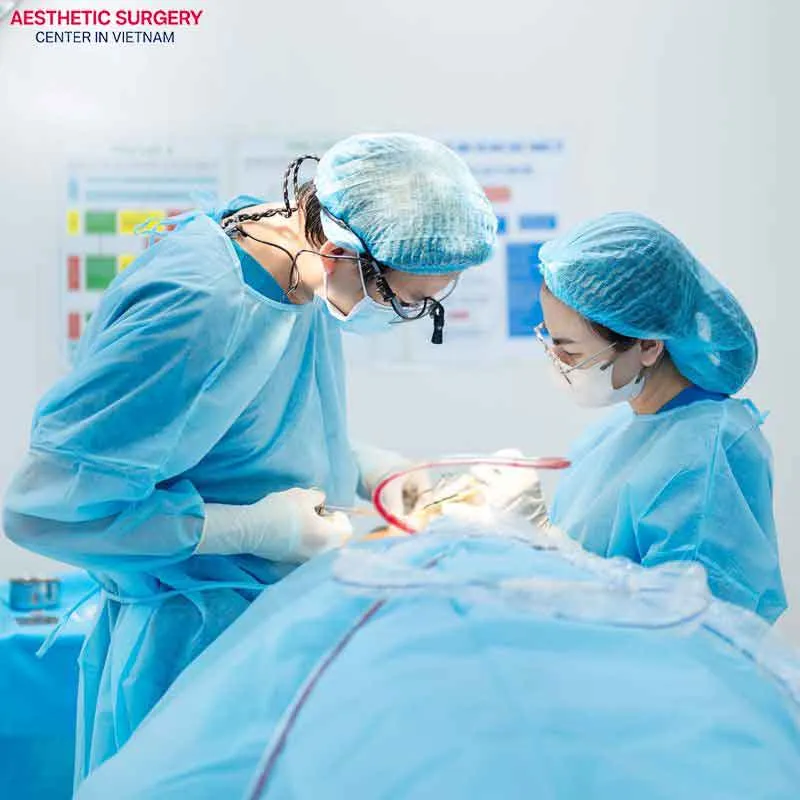
After going through the information provided on breast augmentation, you likely now have a deeper understanding of what the procedure involves, its benefits, and other important knowledge related to this breast enhancement solution. Suppose you’re considering breast augmentation to increase your bust size or enhance breast shape for a more balanced figure. In that case, you can explore reputable services in Vietnam, such as those offered by Aesthetics Surgery Center. Contact the hotline at 0911 582 499 for detailed consultation and support regarding breast augmentation services!







Comment on the post